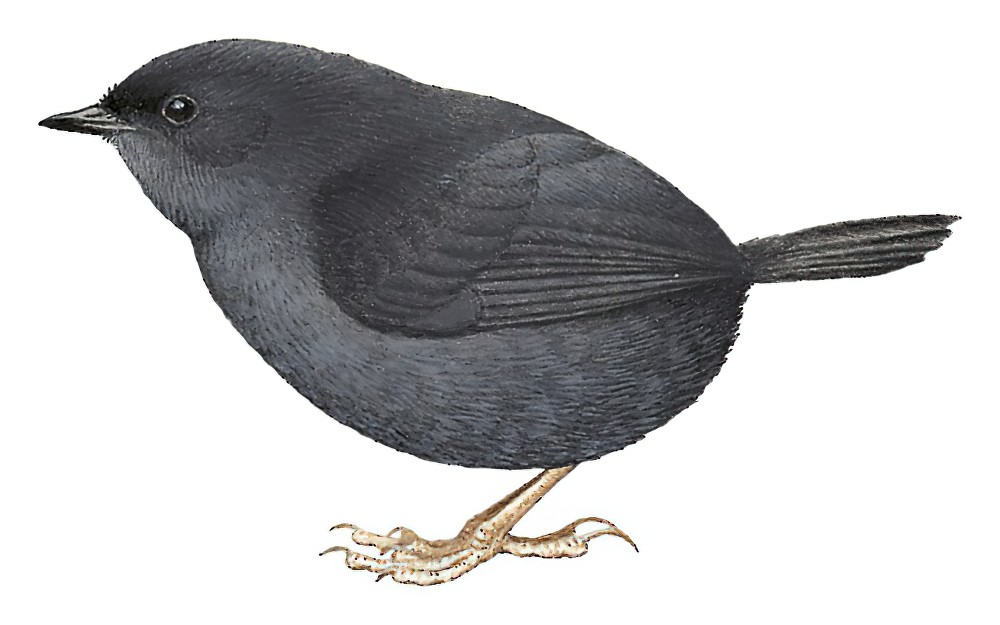Dusky Tapaculo / Scytalopus fuscus

Dusky Tapaculo
SCI Name:
Protonym: Scytalopus fuscus Proc.Zool.Soc.London(1836) (1836), Pt4 no.46 p.89
Taxonomy: Passeriformes / Rhinocryptidae / Scytalopus
Taxonomy Code: dustap1
Type Locality: Chile.
Author: Gould
Publish Year: 1837
IUCN Status: Least Concern
DEFINITIONS
SCYTALOPUS
(Rhinocryptidae; Ϯ Dusky Tapaculo S. fuscus) Gr. σκυταλη skutalē or σκυταλον skutalon stick, cudgel; πους pous, ποδος podos foot; "Mr. Gould also proposed a new genus in the group of Wrens, under the name of Scytalopus, and which he characterized as follows: Genus SCYTALOPUS. Rostrum capite brevius, compressum, obtusum leviter recurvum. Nares basales, membrana tectæ. Alæ concavæ, breves, rotundatæ, remige prima abbreviata, tertia, quarta, quinta et sexta æqualibus. Cauda brevis, rotundata, (pennis externis brevissimis,) laxa. Tarsi elongati, atque robusti, antrorsum scutellis tecti; posterius fasciis angustis cincti, squamis serpentum abdominalibus, haud dissimilibus; halluce elongato et robusto; ungue elongato; digitum anteriorum, medio elongato et gracili. SCYTALOPUS FUSCUS. ... Hab. in Fretu Magellanico, Chili, &c. Hoc genus ad illud in quo Troglodytes veræ amplectuntur maximam affinitatem demonstrat. SCYTALOPUS ALBOGULARIS. ... Hab. in Brasilia." (Gould 1837); "The general contour of form is that of Troglodytes ... the tail is even shorter than in that genus, and consists of decomposed feathers, the whole has a rugged and disunited appearance; and lastly, the tarsi have their posterior aspect regularly banded with narrow scales, instead of having one or two continuous laminæ on that part. ... Tarsi long and stout, the forepart covered with large scutellæ; the hind part bound round with narrow scales, like the abdominal scales of snakes; hind toe long and rather stout, claw long; middle toe long and slender, and with the other two fore toes furnished with fine nails." (Gould 1851); "Scytalopus Gould, Proc. Zool. Soc. London, pt. 4, 1836 (1837), p. 89. Type, by subsequent designation, Sylvia Magellanicus (Lath.) = Motacilla magellanica Gmelin (G. R. Gray, List Gen. Bds., 1840, p. 19)." (Peters 1951, VII, 283) (see Myornis).
Var. Scytolopus.
Synon. Agathopus, Sylviaxis.
fuscus
L. fuscus brown, dusky, dark-coloured, black (see also fusca).
● ex “Merula Philippensis” of Brisson 1760 (syn. Acridotheres tristis).
● ex “Brown Thrush” of Latham 1783, and Pennant 1785 (syn. Catharus swainsoni).
● ex “Alondra parda” of de Azara 1802-1805, no. 147 (Cinclodes).
● ex “Sucrier Namaquois” or “Sucrier à Caleçon Blanc” of Levaillant 1812, pl. 296 (Cinnyris).
● "77. SCOLOPAX. ... fusca. 3. S. rostro arcuato, pedibus rubris, corpore fusco, cauda basi alba. Numenius fuscus. Catesb. car. I. p. 83. t. 83. Habitat in America. Antecedentes 1. 2. 3. structura nimis affines, sed colore corporis diversæ." (Linnaeus 1758) (syn. Eudocimus albus ☼) (see ruber and albus).
● ex “Brown-headed Oriole” of Pennant 1785 (syn. Euphagus carolinus).
● ex “Martin-pêcheur de la côte Malabar” of d’Aubenton 1765-1781, pl. 894 (syn. Halcyon smyrnensis).
● "69. LARUS. ... fuscus. 4. L. albus, dorso fusco. Fn. svec. 126. Habitat in Europa." (Linnaeus 1758) (Larus).
● ex “Brown Merganser” (= ♀) of Pennant 1785 (?syn. Lophodytes cucullatus).
● ex “Mésange Brune à Poitrine Noire” of Levaillant 1804, pl. 139, fig. 1 (syn. Melaniparus afer).
● ex “Brown-headed Oriole” of Pennant 1785 (syn. Molothrus ater).
● (Boddaert 1783) ex “Vautour de Malthe” of d’Aubenton 1765-1781, pl. 427 (= ☼) (syn. Neophron percnopterus).
● (J. Gmelin 1788) ex “Vultur fuscus” of Brisson 1760, “Vautour de Malthe” of d’Aubenton 1765-1781, pl. 427, and de Buffon 1770-1783, and “Avoltojo Griffone” of Cetti 1776 (syn. Neophron percnopterus).
● ex “Brown Pelican” of Latham 1785 (syn. Pelecanus occidentalis).
● ex Tringa lobata Linnaeus, 1758, and “Phalarope cendré” and “Phalarope brun” of Brisson 1760 (syn. Phalaropus lobatus).
● ex “Little Dusky Parrot” of Edwards 1764 (Pionus).
● ex “Merle huppé du cap de bonne Espérance” of d’Aubenton 1765-1781, pl. 563, fig. 1 (syn. Pycnonotus cafer).
● ex “Black-cap Fly-catcher” of Catesby 1731-1743, and Latham 1783, “Muscicapa carolinensis fusca” of Brisson 1760, “Gobe-mouche noirâtre de la Caroline” of de Buffon 1770-1783, and “Black-headed Fly-catcher of Pennant 1785 (syn. Sayornis phoebe).
● ex “Brown Tody” of Latham 1781 (unident.).
UPPERCASE: current genus
Uppercase first letter: generic synonym
● and ● See: generic homonyms
lowercase: species and subspecies
●: early names, variants, mispellings
‡: extinct
†: type species
Gr.: ancient Greek
L.: Latin
<: derived from
syn: synonym of
/: separates historical and modern geographic names
ex: based on
TL: type locality
OD: original diagnosis (genus) or original description (species)












